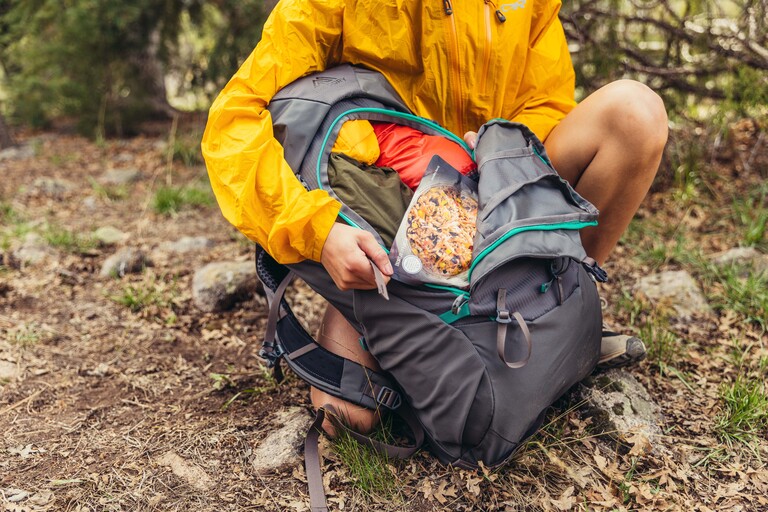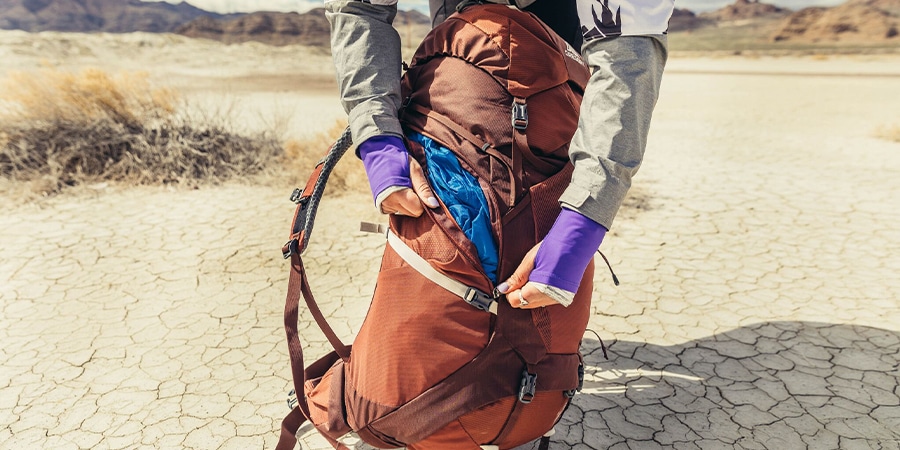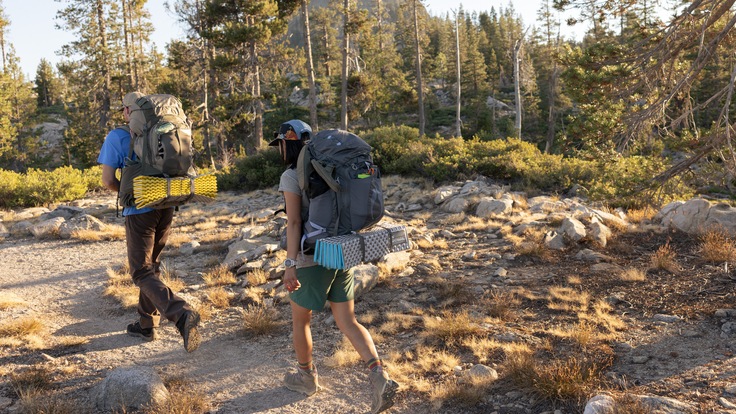The most important piece of gear you need to go backpacking is—you guessed it—a backpack. Your backpack will hold all your overnight gear and, if it's a good one, feel comfortable all the while. Luckily, we carry a whole bunch of good ones at REI. But which is right for you? Well, that depends.
The first thing you'll want to nail down is how many nights you plan to spend outside, which will help you determine the right capacity for your needs. Then it's about deciding what features you care about most and finding the right fit. Check out our How to Choose a Backpack article for a deep dive on fit, features, capacity and more or jump to our Buying Advice below for a snapshot. Then read on for our favorite haulers for everything from quick overnights and weeklong epics to multisport pursuits and ultralight adventures.
Staff Picks
Find quick recommendations below or scroll down for in-depth reviews.
- Best Backpack for Overnight Trips: Gregory Jade 43 and Gregory Zulu 45
- Best Backpack for Weekend Trips: Osprey Aura AG 50 and Osprey Atmos AG 50
- Best Backpack for Weeklong Trips: Gregory Deva 70 and Gregory Baltoro 75
- Best Backpack for Multisport Trips: Osprey Ariel 65 and Osprey Aether 65
- Best Backpack for Ultralight Trips: REI Co-op Flash Air 50 (Women's and Men's)
- Most Versatile Backpacking Pack: Deuter Aircontact Core 45 + 10 SL and Deuter Aircontact 50 + 10
Gregory Jade 43 (Women's) and Gregory Zulu 45 (Men's)
Best Backpack for Overnight Trips
Gregory Jade 43 Pack
Weight 3 lbs. 6.4 oz. (XS/S), 3 lbs. 6.4 oz. (S/M) Jade 43; 3 lbs. 8.3 oz. (S/M), 3 lbs. 11.4 oz. (M/L) Zulu 45
Capacity 41 liters (XS/S), 43 liters (S/M) Jade 43; 43 liters (S/M), 45 liters (M/L) Zulu 45
Fits (Waist/Hips) 24–46 inches (XS/S), 25–48 inches (S/M) Jade 43; 25–48 inches (S/M), 27–53 inches (M/L) Zulu 45
Material Nylon/closed-cell foam (Jade 43); 40% recycled polyester (Zulu 45)
Backpackers seeking a perfect sack for one-night trips that can do double duty for day hikes love the Gregory Jade 43 (women’s) and Zulu 45 (men’s) for their just-right size and versatility. The capacity and feature set (more on this later) allow wearers to adapt the packs to a range of uses, from carrying extra toddler gear on a day trip to quick overnights and even multiday treks if you pack ultralight. Tim Bird, a department manager at the REI store in Farmington, Utah, recommends the Jade and Zulu to members who want a pack that works for several types of adventure.
A large U-shaped zipper on the front of the pack offers fast access to items stashed inside—even gear on the bottom, which can be tricky to see and grab with a traditional top-loaded design. Other organizational details include a stretch-mesh outer pouch (perfect for stashing a wet rain shell), a strap on the shoulder harness for sunglasses and zippered pockets on the hipbelt to keep snacks and a smartphone within reach.
The pack’s dynamic suspension design (which incorporates a lower back panel that moves independently from the bag) also earns props from backpackers who like how the hipbelt shifts with their body, not the load. Women report improved comfort with the Jade’s sculpted shoulder harness (the straps curve inward more than on the men’s version), says Erica Schiller, a sales specialist at the Denver, Colorado, REI store. “When other packs may pinch or press in the wrong spots around our shoulders, the Jade often provides alleviation as it is designed specifically for female upper-body shapes,” Schiller explains.
The men’s version provides similar comfort with its wider straps. Says one customer-reviewer: "I bought this pack for my son’s 15th birthday, and we just finished a 37-mile backpacking trip in the Alpine Lakes Wilderness in Washington state. He said the comfort was amazing even under a 40-pound load, and he loved how simple but well-built it is."
Backpackers also appreciate the lower price point: At $200, it’s the most affordable pack on this list. Buy women's. Buy men's.
Osprey Aura AG 50 and Osprey Atmos AG 50
Best Backpack for Weekend Trips


Osprey Aura AG 50 Pack
Weight 4 lbs. 3 oz. (XS/S), 4 lbs. 5 oz. (M/L) Aura AG 50; 4 lbs. 5 oz. (S/M), 4 lbs. 8 oz. (LG/XL) Atmos AG 50
Capacity 47 liters (XS/S), 50 liters (M/L) Aura AG 50; 50 liters (S/M), 53 liters (L/XL) Atmos AG 50
Fits (Waist/Hips) 26–50 inches (XS/S), 28–50 inches (M/L) Aura AG 50; 28–50 inches (S/M), 30–50 inches (L/XL) Atmos AG 50
Material Recycled nylon (bluesign®-approved)
One surefire way to identify a good pack: Take note of what you see on the trail. The beloved Osprey Aura AG 50 (women’s) and Atmos AG 50 (men’s) are about as common as dandelions, and for good reason. Devotees praise the innovative AntiGravity (or "AG") suspension system, which makes bigger loads feel—get it?—almost weightless during multi-night trips. In lieu of a thick foam back panel, the Aura AG 50 and Atmos AG 50 use a trampoline-style 3D-suspended mesh all the way from the perimeter and through the lumbar and hipbelt. This allows for complete contact across your back to mitigate pressure points (important when carrying a load over several days) and provide superb load transfer to your hips. It also gets the bag off your back to encourage airflow.
“The suspended mesh molds to your body and conforms to your movement and posture,” says Carlos Rodriguez, hard goods department manager at the REI Co-op store in Wichita, Kansas. That conformability appeals to hikers such as Atlanta REI store senior sales specialist Elizabeth Nguyen, who has scoliosis. “The mesh back of the Aura makes it the pack for me,” she says.
Two easy-to-reach side pockets hold 32- to 48-ounce water bottles, loops on each side of the pack can stow trekking poles and a packable rain cover is included. All the Aura and Atmos’ materials are bluesign®-approved, made with 100% recycled materials and have a nonfluorinated durable water repellant (DWR) finish. Buy women's. Buy men's.
Gregory Deva 70 and Gregory Baltoro 75
Best Backpack for Weeklong Trips


Gregory Deva 70 Pack
Weight 4 lbs. 11.2 oz. (XS), 4 lbs. 11.2 oz. (S), 5 lbs. 1.6 oz. (M) Deva 70; 4 lbs. 12.8 oz. (S), 5 lbs. (M), 5 lbs. 6.4 oz. (L) Baltoro 75
Capacity 65 liters (XS), 70 liters (S), 75 liters (M) Deva 70; 70 liters (S), 75 liters (M), 80 liters (L) Baltoro 75
Fits (Waist/Hips) 26–48 inches (XS), 26–48 inches (S), 28–50 inches (M) Deva 70; 26–48 inches (SM), 28–50 inches (M), 30–52 inches (L) Baltoro 75
Material 2,100-denier high-density 40% recycled nylon, 420-denier high-density 45% recycled nylon (body); 135-denier 40% postconsumer recycled polyester (lining)
Yes, the Baltoro 75 (men’s) and Deva 70 (women’s) from Gregory weigh more than some large-capacity packs, but what they lack in weight savings they make up for in comfort—a detail that matters on weeklong epics. “The hipbelt, shoulder harness and back panel are extra cushioned, and the frame is sturdier, allowing the Baltoro/Deva to comfortably carry loads of up to 50 pounds,” says Tim Bird, department manager at the REI store in Farmington, Utah. The ultraplush lumbar pad molds to your back and fills in the space between your lower back and the pack, preventing the hipbelt from sliding down as you hike (a drift that can transfer the load from the pack’s suspension to your body). “Many customers say that the extra cushioning makes the additional weight less noticeable,” Bird says. And because a patented FreeFloat suspension design features a hipbelt, lower back panel and shoulder straps that flex with your body, heavy loads also feel less blocky and cumbersome.
The mostly mesh back panel also provides better ventilation than you might expect from such a padded pack. As with smaller-capacity Gregory packs like the Jade and Zulu, organizational features abound, including a U-shaped zipper on the front of the main body that lets hikers see the entire pack’s contents at a glance. One Baltoro/Deva feature even appeals to your nose: The fabric has a Polygiene® Stays Fresh Technology finish that inhibits the growth of odor-causing bacteria. And a cleverly angled water bottle holster makes it easy to grab and replace a 32-ounce vessel without removing the pack. Buy women’s. Buy men's.
Osprey Ariel 65 and Osprey Aether 65
Best Backpack for Multisport Trips
Osprey Ariel 65 Pack
Weight 4 lbs. 13.6 oz. (XS/S & EF XS/S), 4 lbs. 14.3 oz. (M/L & EF M/L) Ariel 65; 4 lbs. 14.7 oz. (S/M & EF S/M), 4 lbs. 15.4 oz. (L/XL & EF L/XL) Aether 65
Capacity 62 liters (XS/S & EF XS/S), 65 liters (M/L & EF M/L) Ariel 65; 65 liters (S/M & EF S/M), 68 liters (L/XL & EF L/XL) Aether 65
Fits (Waist/Hips) XS/S
Material 420HD nylon packcloth; 210-denier nylon Diamond (bluesign® approved)
If you're the sort of adventurer who plans to use your load hauler for backpacking as well as climbing, backcountry skiing and more, look no further than the Aether 65 (men’s) and Ariel 65 (women’s) from Osprey. These packs, made with bluesign®-approved materials, can accommodate climbing gear, wet items, fishing equipment—virtually everything short of a packraft. Dedicated anchor points attach to the 13-liter Osprey Daylite Pack (sold separately), allowing summit-baggers to travel light with the smaller sack and leave their larger one and any unnecessary gear at a backcountry base camp. The stretchy outer pouch can fit a pair of fishing waders or wading boots or be used to store soggy items away from food and insulating layers in the main compartment.
Finding the right fit is also easier with the Aether and Ariel, thanks to extended sizing. The packs come in multiple torso sizes and multiple widths. Look for an “EF” (which stands for “extended fit”) when choosing among XS/S, M/L, S/M and L/XL options—the extended XS/S, for example, adds between 14 and 25 inches to the waist and hip circumference. “This allows me, as a pack fitter, to accommodate larger body types more easily and provides those backpackers with a more precise and comfortable fit, which is a game changer for many customers,” says Tim Bird, a department manager at the REI store in Farmington, Utah.
All that versatility comes with a weight penalty, though. The smallest size of either pack is nearly 5 pounds—about a pound more than many other 65-liter bags sold at REI. Buy women’s. Buy men’s.
REI Co-op Flash Air 50 (Women's and Men's)
Best Backpack for Ultralight Trips
REI Co-op Flash Air 50 Pack
Weight 1 lb. 12 oz. (XS), 1 lb. 13 oz. (S), 1 lb. 14 oz. (M) women’s; 1 lb. 13 oz. (S), 1 lb. 14 oz. (M), 1 lb. 15 oz. (L) men’s
Capacity 49 liters (XS), 50 liters (S), 51 liters (M) women’s; 49 liters (S), 50 liters (M), 51 liters (L) men’s
Fits (Waist/Hips) 30–38 inches (XS), 32–40 (S), 34–44 inches (M) women’s; 32–40 inches (S), 34–42 inches (M), 36–46 inches (L) men’s
Material UHMWPE ripstop nylon (87% nylon/13% polyethylene; bluesign® approved)
If fast-and-light adventures are your jam, then this sub-2-pound backpack could be for you. Offered in three sizes in both men’s and women’s versions, the Flash Air 50 from REI Co-op uses a lightweight spring steel frame and a sturdy, padded hipbelt to support loads weighing up to 25 pounds. Most of its weight savings comes from weaving ripstop nylon (a lightweight, sturdy fabric) with ultra-high-molecular-weight polyethylene (a fabric that is highly resistant to tears) for a pack that is light yet durable. The bluesign®-approved material has a nonfluorinated durable water repellant (DWR) finish.
“I was a bit wary of an REI product that was so lightweight,” says one customer-reviewer. "Ultralight backpacking packs are hard to make well, but this was a goodie.”
This pack's features might be few (as you'd expect from gear designed for ultralight adventures), but they're clever. Customizable compression straps can be reconfigured to adjust the pack shape to your unique load. Open-topped side pouches adapt to a variety of objects, from water bottles to tent poles (a cinch cord prevents skinnier items from sliding out). A roll-top closure instead of a top lid allows you to adjust pack size to your cargo while keeping rain out. One detachable mesh pouch comes included with the pack so hikers can decide where they want small-item storage. Additional accessories (sold separately) allow further customization. “If I were thru-hiking the Appalachian Trail today, the Flash Air Pack would be at the top of my list for a lightweight thru-hiking pack,” says Tim Bird, department manager at the Farmington, Utah store. “The biggest downside of this pack is that it lacks the adjustability of a traditional full-size pack,” Bird continues. “It fits the majority of folks who try it on, but if it doesn’t fit, there’s often very little that can be done.” Buy women's. Buy men’s.
Deuter Aircontact Core 45+ 10 SL and Deuter Aircontact 50 + 10
Most Versatile Backpack
Deuter Aircontact Core 45 + 10 SL Pack
Weight 4 lbs. 4.4 oz. (women’s), 4 lbs. 9 oz. (men’s)
Capacity 55 liters (women’s), 60 liters (men’s)
Fits (Waist/Hips) Unavailable
Material At least 50% recycled 235-denier polyamide (main); 500-denier textured polyamide (bottom/high-wear areas on hipbelt)
The ultra-adjustable Aircontact Core 50 + 10 and Aircontact 45 + 10 from Deuter are impressively versatile for their price point, allowing backpackers to invest in one pack for multiple scenarios. This adaptability is in part thanks to an adjustable back panel that can fit most people, tall or small—it features a webbing “ladder” and sturdy hook-and-loop tab that lets backpackers quickly and easily adjust the distance between the hipbelt and shoulder harness for on-trail fit adjustments or even a pack swap among trail mates. (One backpacking couple with a toddler takes turns carrying the child carrier pack and the Aircontact Core.) While there are two other packs in this guide that feature an adjustable panel (the Osprey Ariel and Osprey Aether), what sets this Deuter duo apart is the range of modification: Users can tighten or elongate the Aircontact 45 + 10 SL to fit someone as short as 5-foot-1 and as tall as 5-foot-8. The Aircontact Core 50 + 10 can fit a person up to 6-foot-7. Adding to each pack’s versatility is an expandable collar that enlarges or shrinks the bag depending on the load (this is where the "plus-10" liters comes from).
Other features to love: A cushioned belt cradles the hip bones and supports heavy loads. The packs’ organizational details rival the feature-forward Gregory Zulu and Jade with a large, stretchy outer stash pocket; a stow port for sunglasses on the shoulder strap; a side pouch to secure tent poles or a fly rod; and two zippered pockets on the hipbelt for easy-to-reach snacks. Our one gripe: While there’s a hydration bladder port, there’s no dedicated holster to secure a bottle. Buy women’s. Buy men’s.

Buying Advice for Backpacking Backpacks
When shopping for a backpacking pack, consider three things: volume (or capacity), features and fit.
Volume
Most packs list their claimed capacities in their name: The Gregory Jade 43, for instance, carries 43 liters of stuff. You want a pack that's as small as your desired backpacking trips will allow. Too-big packs will add weight and bulk, which can make your hike uncomfortable. As with all things "backpacking," remember the old thru-hiker adage: Ounces make pounds, and pounds make pain.
- 1-3 Days: In general, assume that for one to three nights out, you can get away with a smaller pack in the ballpark of 30 to 50 liters. Packs in this range can easily hold essentials like a sleep system, a change of clothes, some layers and food and water for a few days. It requires some discipline to fit your gear in a pack this small, but that can also be a good insurance policy against overpacking.
In this guide, the smaller-volume packs are the Gregory Jade 43, Gregory Zulu 45, Deuter Aircontact Core 45 + 10 SL and Deuter Aircontact 50 + 10. - 3-5 Days: For multiday trips (or shorter trips where you intentionally want to pack a little more luxuriously), aim for something in the range of 50 to 80 liters. This gives you a bit more wiggle room (literally) and is the most versatile option.
Among our Staff Picks, most packs fall in this range: the Osprey Aura AG 50 and Osprey Atmos AG 50, REI Co-op Flash Air 50, Osprey Ariel 65 and Osprey Aether 65 and the Gregory Deva 70 and Gregory Baltoro 75. - 5+ Days: For gonzo epics, you need at least 70 liters or more. These packs not only fit the most gear, but tend to have the most robust suspension systems, which are designed for 50-plus-pound loads.
The only packs in this guide that fall in this category are the Gregory Deva 70 and Gregory Baltoro 75.
Features
There are myriad features to consider when buying a pack, including frame type, ventilation, pack access, organization and padding. Check out How to Choose a Backpack for an in-depth description of each one, or continue reading for a quick overview.
- Frame Type There are three main frame types: internal, external and frameless.
- Internal Frame Backpacks : Like the majority of packs sold at REI, all bags on this list have an internal frame, meaning the pack's structure is hidden inside the back panel. Packs with this style frame are great at providing stability for most loads.
- External Frame Backpacks: External-frame packs have structural hardware on the outside of the pack and are a good choice if you're carrying a heavy or uneven load, like an inflatable kayak.
- Frameless Backpacks: Frameless packs are popular among ultralight backpackers who want to trim ounces. However, frameless packs provide less support and comfort under heavy hauls.
- Ventilation Some packs have features that encourage air flow between the bag and your body. If you often end up with a sweat-drenched back while backpacking, you may want to consider a pack with a suspended mesh back panel—it's essentially a trampoline-style component that sits between your bag's back panel and your body to allow air to pass through. If you're trekking in cold temps or run cool, this feature may not matter as much to you.
- Pack Access Many packs have a top-loading design, meaning you unzip the top of the bag to access your stuff inside (most packs on this list are top-loaders). Some, like the Gregory Jade 43 and Gregory Zulu 45, also have a U-shaped opening on the front for easy access to items at the bottom of the bag.
- Organization A sleeping bag compartment, hydration sleeve, bottle holders, hipbelt pockets, trekking pole attachments, adjustable back panel and top lid pocket (often called a pack's "brain") are organizational features you may or may not want, depending on your personal preferences. To choose, consider questions like: Do I drink from a water bottle or hydration bladder? Is there space for a reservoir? Do I want the ability to adjust the back panel to fit another hiker in my family? What items do I want within easy reach? Do I want loops for trekking poles or an ice axe?
- Padding The lighter your pack, the less padding it generally has. This means less comfort under heavy hauls, so you'll want to pack lean if you chose a lightweight bag. If you care more about cushion, consider an option with, you guessed it, more cushion. The REI Co-op Air Flash 50 is the only ultralight pick in this lineup—and though its contoured hip belt and lightly padded shoulder straps help balance comfort with weight savings, you'll still want to pack lighter than you would with a more padded pick like the Osprey Ariel 65 or Osprey Aether 65.
Fit
Most packs come in multiple versions and sizes to accommodate different bodies, so it's important to know your torso length and hip circumference. Learn how to measure both in our How to Size and Fit a Backpack article. Some packs, like the Osprey Ariel 65 and Osprey Aether 65, come in extended sizes that add inches at the waist and hips.
Methodology

We polled Expert Advice staffers and backpack sales leads across the co-op for their favorite backpacks for everything from overnight adventures to multiday epics. These are their top choices.



























